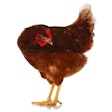
Despite an on-going program to protect the nation’s commercial ducks from highly pathogenic avian influenza (HPAI) though vaccination, a first outbreak of the season has been registered in these birds in France. Five other European countries have also confirmed new outbreaks in commercial poultry.
In France, the first cases of HPAI have been detected on a duck farm where the birds have been vaccinated against the disease.
On January 2, the French agriculture ministry confirmed the outbreak in Vendée, a department in the western region of Pays de la Loire. The outbreak is also the country’s first in the 2023-2024 season to affect ducks, as well as in the department and region.
It brings to seven the total number of outbreaks on the nation’s poultry farms since the end of November.
Under standard procedures following an HPAI outbreak in poultry, the Vendée local authority has designated a 3-km protection zone and 10-km surveillance zone around the infected premises. Within these zones, movements of poultry and other birds are prohibited — except with official authorization — and surveillance has been stepped up.
Depopulation of the around 8,700 ducks at the infected farm has been carried out. The owner will receive financial compensation for the resulting losses.
Last October, France commenced the country’s first HPAI vaccination program, which included the mandatory administration of a vaccine to all commercial ducks. By December 8, first vaccine doses had been administered to more than 8.8 million ducks across France, the agriculture ministry reported.
HPAI farm outbreaks in five other European states
Officially registering the most new HPAI outbreaks on commercial farms over the past 10 days has been the Republic of Moldova.
According to the latest notifications to the World Organisation for Animal Health (WOAH), presence of the HPAI virus has been confirmed at 11 poultry farms during this period. Of these, nine were in the northern district of Drochia, and one each in Floresti and Rezina. In the latter two districts, the outbreaks followed a 10-month hiatus from the disease. In each district, the source of infection has been attributed to contact with wild species.
Since HPAI returned to Hungary in early November, outbreaks in poultry have been recorded in nine counties across the country. Although the disease has affected premises with different types of poultry, many have involved farms with commercial ducks or geese.
Latest reports to WOAH outline six further outbreaks. Affected were two locations in each of Szabolcs-Szatmar-Bereg and Gyor-Moson-Sopron in the north, as well as one each in Jasz-Nagykun-Szolnok and Csongrad-Csanad. These counties are located in central and southern Hungary, respectively.
Poland’s last outbreaks of 2023 brought the country’s total for the year to 68, directly impacting around 1.29 million poultry.
Latest to be affected were commercial flocks of meat turkeys — one in each of the central-eastern province of Mazovia, and Lower Silesia in the south-west. These were followed soon after the New Year by an outbreak in breeding ducks, also in Lower Silesia.
In Belgium, there were two outbreaks on farms in Western Flanders in the last week of December. Affected were around 25,200 turkeys and 33,400 chickens, according to the latest WOAH notifications.
Latest outbreak in a German poultry flock to be reported to the agency occurred in the northern state of Schleswig-Holstein. Affected were 1,500 laying hens, according to the national veterinary reference laboratory, Friedrich-Loeffler Institute.
Four nations record new cases in backyard flocks
One backyard flock of poultry or other bird species has been registered with WOAH in each of the following countries: the Czech Republic (Czechia), Germany, Moldova, and Ukraine. At each location, between 30 and 208 birds were affected.
For Moldova, the outbreak was the first ever detected in the Southern Region’s district of Stefan Voda. In the Czech Republic, it represented the first occurrence of the disease in the South Bohemian region following a five-month hiatus.
The other outbreaks in this category were in the northeast German state of Mecklenburg-Western Pomerania, and in Sumy oblast in northeastern Ukraine.
In all these outbreaks involving poultry, presence of the H5N1 virus serotype was confirmed.
Cases in wild birds detected widely across Europe
Over the past 10 days, veterinary authorities of 12 European nations have registered with WOAH one or more cases of HPAI in their respective wild bird populations.
In almost all of these latest outbreaks, the H5N1 virus serotype has been involved, and cases have been detected across the continent from Ukraine to Sweden and Portugal.
Based on WOAH notifications, worst affected lately has been in Moldova. Over this period, it has confirmed 282 new cases. Covering seven districts in the northern and central regions, almost all of these were in wild swans, including some mass mortality events involving 260 birds.
In Romania, 58 further cases have been confirmed to WOAH, and there have been 25 more cases in seven German states.
Registering with WOAH smaller numbers of cases have been Austria, France, Poland, Portugal, Spain, Sweden, Switzerland, Ukraine, and the United Kingdom.
One of the recently reported cases in Sweden was in a falcon, which tested positive for an HPAI virus of the H5 family in early November.
The European Commission has not updated its Animal Disease Information System since December 16.
WOAH has recently advocated vaccination of poultry against HPAI as part of a broader strategy to prevent the spread of the disease.
View our continuing coverage of the global avian influenza situation.
















